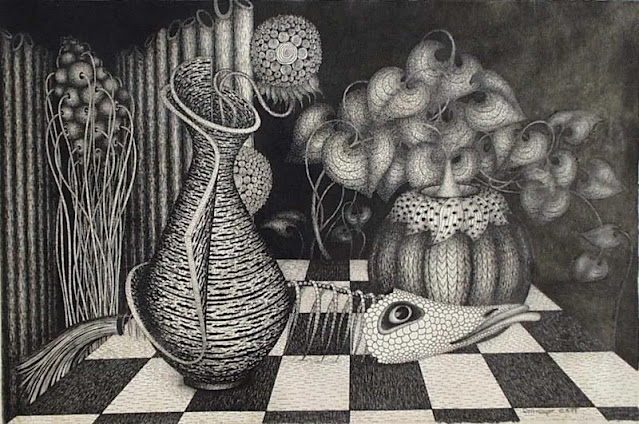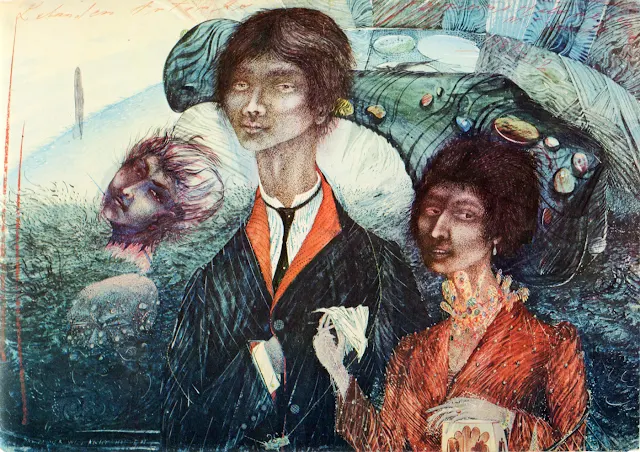The Vienna School of Fantastic Realism (Wiener Schule des Phantastischen Realismus) is a captivating and influential art movement that emerged in Vienna, Austria, in 1946. This group of visionary artists forged a unique path in the post-war art world by combining meticulous realism with fantastical, often surreal, themes. This movement stood in stark contrast to the abstract art that was predominant at the time, offering a rich, detailed, and symbolic alternative.
Historical Context and Origins
The end of World War II marked a period of profound change and reconstruction in Europe. The devastation and subsequent rebuilding efforts influenced various cultural and artistic expressions. Amidst this backdrop, a group of artists in Vienna sought to reconnect with the detailed craftsmanship and symbolic richness of earlier artistic traditions while addressing contemporary themes and existential questions.
The Vienna School of Fantastic Realism was founded in 1946, with its roots tracing back to the teachings of Professor Albert Paris Gütersloh at the Vienna Academy of Fine Arts. Gütersloh emphasized the techniques of the Old Masters, akin to the detailed and realistic styles of early Flemish artists such as Jan van Eyck. This grounding in classical techniques provided the foundation for the fantastic realist painters, enabling them to merge detailed realism with imaginative and esoteric subject matter.
Coining of the Term and Early Exhibitions
The term "Fantastic Realism" was coined by Johann Muskik in the 1950s. It aptly described the movement's distinctive blend of fantastical themes and realistic execution. The first major exhibition of the Vienna School of Fantastic Realism took place in 1959 at the Vienna Belvedere, an event that marked the formal recognition of the group and its unique artistic vision.
Core Philosophies and Artistic Approach
The Vienna School of Fantastic Realism is characterized by its use of religious, mythological, and esoteric symbolism, combined with a meticulous naturalistic style. This approach distinguishes it from Surrealism, which often employed more abstract and less detailed techniques. The artists of the Vienna School believed in the power of imagination, dreams, and the subconscious, exploring themes that transcend ordinary reality.
Their works are known for their vivid colors, intricate details, and complex compositions. These elements work together to create a sense of otherworldliness and invite viewers to explore the deeper meanings and narratives embedded within each piece. The movement's dedication to traditional techniques allowed these artists to achieve a level of detail and realism that enhanced the fantastical elements of their work.
Prominent Artists and Their Contributions
Ernst Fuchs is one of the most prominent figures of the Vienna School of Fantastic Realism. His works are renowned for their visionary and mystical qualities. Fuchs often explored themes of religion, mythology, and mysticism, utilizing a technique known as "mischtechnik." This method involves layering egg tempera and oil paints to create a luminous and detailed effect. Some of his notable works include "Moses and the Burning Bush" and "The Triumph of the Cross," which exemplify his mastery in blending the real with the fantastical.
Fuchs' influence extended beyond his paintings. He was also a sculptor, architect, and writer, contributing to a broader understanding and appreciation of the movement. His commitment to preserving traditional techniques and integrating them with modern themes has left a lasting legacy.
Arik Brauer's art is characterized by its whimsical, allegorical nature. His paintings often depict fantastical landscapes filled with surreal creatures and enigmatic figures. Brauer's use of vibrant colors and intricate details creates a dreamlike quality that draws viewers into his unique vision of the world. Some of his notable works include "The Happy Hunter" and "The Inverted World." Brauer's ability to weave complex narratives into his art makes his work both engaging and thought-provoking.
In addition to his visual art, Brauer was a singer and poet, adding another dimension to his storytelling. His multidisciplinary approach enriched his artistic output and provided a deeper context for his paintings.
Wolfgang Hutter's art is marked by its intricate detail and rich symbolism. His paintings often explore themes of transformation and metamorphosis, depicted through fantastical scenes and elaborate compositions. Hutter's works, such as "The World Tree" and "The Alchemist," showcase his ability to merge the real and the imaginary, creating visual narratives that are both captivating and profound. His meticulous attention to detail invites viewers to explore every aspect of his compositions, uncovering layers of meaning.
Anton Lehmden's paintings are characterized by dynamic compositions and vivid imagery. His works often depict apocalyptic scenes and cosmic landscapes, reflecting his interest in the forces of nature and the universe. Lehmden's use of bold colors and dramatic contrasts adds a sense of intensity and movement to his art. Notable works include "The Creation" and "The Cosmic Battle." Lehmden's exploration of grand themes and his dramatic style make his works both powerful and evocative.
Lehmden was also a prolific teacher, influencing many young artists through his professorship at the Vienna Academy of Fine Arts. His dedication to both his own art and the education of others ensured the continuation and evolution of the movement's ideals.
Helmut Leherb, known as Maître Leherb, was another key figure in the Vienna School of Fantastic Realism. His work is distinguished by its surreal, often macabre themes, and its meticulous detail. Leherb's paintings frequently explore the darker aspects of the human psyche, using symbolism to delve into existential questions and philosophical themes. His notable works include "The Last Supper" and "The Garden of Earthly Delights."
Leherb's contribution to the movement extended beyond his paintings. He was an influential teacher and mentor to many young artists, helping to spread the principles and techniques of Fantastic Realism.
Zeev Kun, an Israeli artist who joined the movement, brought a unique perspective to the Vienna School of Fantastic Realism. His works often explore themes of identity, exile, and cultural heritage, depicted through a blend of realistic and surreal elements. Kun's paintings, such as "The Wandering Jew" and "The Return," reflect his deep connection to his roots and his exploration of the human condition. His ability to merge personal and universal themes makes his work both poignant and relatable.
The Big Five and International Recognition
The core members of the Vienna School, often referred to as "The Big Five" – Hausner, Fuchs, Hutter, Brauer, and Lehmden – played a crucial role in bringing international recognition to the movement. Their exhibitions spanned across Europe and the United States, captivating audiences with their extraordinary vision and technical prowess.
Rudolf Hausner, one of the older members, along with Kurt Regschek and Fritz Janschka, emigrated to the United States in 1949. Kurt Regschek, in particular, played a significant role in organizing early exhibitions of the group in the U.S. in 1965. These exhibitions helped introduce the movement to a wider audience, cementing its place in the international art world.
Techniques and Artistic Processes
The artists of the Vienna School of Fantastic Realism employed a range of traditional techniques to achieve their distinctive style. They were deeply influenced by the methods of the Old Masters, particularly in their use of light, shadow, and perspective. These techniques allowed them to create highly detailed and realistic images, which served as a foundation for their fantastical themes.
One of the most notable techniques used by these artists is "mischtechnik," a method that combines egg tempera and oil paints. This technique, revived and refined by Ernst Fuchs, involves applying layers of transparent egg tempera over a monochrome underpainting, followed by glazes of oil paint. The result is a luminous, almost ethereal quality that enhances the fantastical elements of the work.
Symbolism and Themes
The Vienna School of Fantastic Realism is renowned for its rich use of symbolism and exploration of complex themes. The artists often drew upon religious, mythological, and esoteric traditions, imbuing their works with layers of meaning. This symbolic depth invites viewers to engage with the paintings on multiple levels, uncovering hidden narratives and philosophical reflections.
Common themes in the movement's work include transformation, metamorphosis, the exploration of the subconscious, and the interplay between reality and fantasy. These themes reflect the artists' interest in the mysteries of existence and the human condition. Their works often serve as visual meditations on the nature of reality, the passage of time, and the search for meaning.
Legacy and Influence
The Vienna School of Fantastic Realism has left an indelible mark on the art world, influencing generations of artists and continuing to inspire new movements. Its emphasis on blending the fantastical with the real, and its commitment to meticulous detail and symbolism, set it apart from other art movements of the 20th century.
The movement's legacy can be seen in various contemporary art forms, from surrealism to visionary art, and even in popular culture. Its impact extends beyond the visual arts, influencing literature, film, and other creative disciplines. The Vienna School's celebration of imagination and the subconscious has resonated with audiences around the world, inviting them to explore the depths of their own creativity and perception.
Conclusion
The Vienna School of Fantastic Realism stands as a testament to the power of imagination and the enduring appeal of fantastical art. Its founders and key figures, through their extraordinary vision and technical skill, have created a body of work that continues to captivate and inspire. As a movement, it bridges the gap between the real and the surreal, inviting viewers into a world where anything is possible, and reality is just the starting point for the imagination.
In a world that often emphasizes the tangible and the concrete, the Vienna School of Fantastic Realism reminds us of the importance of dreams, symbols, and the mysteries that lie beyond the surface. Its artists have shown us that through meticulous craftsmanship and a boundless imagination, we can explore new realms of experience and understanding. The Vienna School of Fantastic Realism continues to be a beacon for those who seek to see beyond the ordinary and embrace the extraordinary.










.jpg)







No comments:
Post a Comment